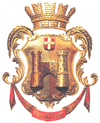Susa, Piedmont
Susa (Latin: Segusio) is a city and comune in Piedmont, Italy. In the middle of Susa Valley, it is situated on at the confluence of the Cenischia with the Dora Riparia, a tributary of the Po River, at the foot of the Cottian Alps, 51 km (32 mi) west of Turin.
History
Susa (Latin: Segusio) was founded by the Gauls. In the late 1st century BC it became voluntarily part of the Roman Empire. Remains of the Roman city have been found in the excavations of the central square, the Piazza Savoia. Susa was the capital of the province of Alpes Cottiae . According to the medieval historian Rodulfus Glaber, Susa was "the oldest of Alpine towns".
In the Middle and Modern ages Susa remained important as a hub of roads connecting southern France to Italy. Taking part of the county or march of Turin (sometimes "march of Susa"). Henry of Segusio, usually called Hostiensis, (c. 1200 – 1271) an Italian canonist of the thirteenth century, was born in the city. During the Napoleonic era a new road, the Via Napoleonica, was built. The city's role as a communications hub has been confirmed recently by a nationwide dispute over the construction of the proposed Turin-Lyon high-speed rail link (TAV) to France.
Main sights
- Susa Cathedral (Italian: Cattedrale di San Giusto) (1029).
- The triumphal Arch of Augustus, erected by a Romanized Sugusian chief to Augustus in 8 BC.
- The Roman Amphitheater.
- Castle of Marquise Adelaide. It is likely located in the same site of the ancient Roman Praetorium.
- Archaeological area of Piazza Savoia.
Twin cities
See also
Sources
External links


